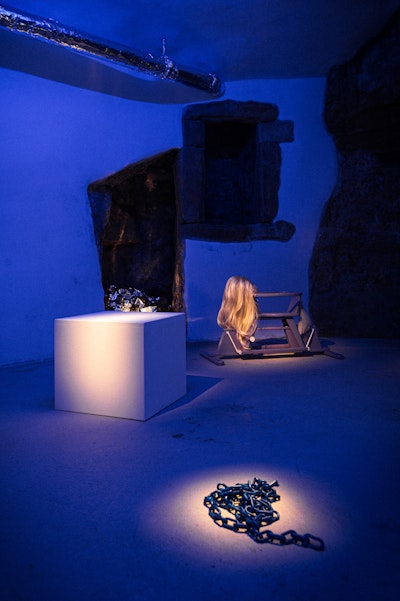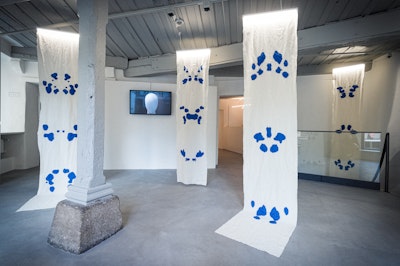Marie-Anne Lorgé
Why do we need art? Stendhal gave the most famous answer upon his return from visiting the Santa Croce Basilica in Florence, in front of the frescoes painted by Volterrano: "I had reached that point of emotion where the celestial sensations given by the Fine Arts and passionate feelings meet. [...] I walked with the fear of falling."
Not everyone is Stendhal? Certainly not. And there's no need to go to Florence or halfway around the world? Of course not. In fact, everyone has their own idea about art, but undeniably, this idea appeals to the senses, the intimate, the intuitions, and the intellect. Not everyone is Volterrano? Certainly not. But who doesn't aspire, more or less secretly, to that space of freedom embodied by creation? A crucial aspect that no longer needs to be proven. And so, those « passionate creators" commit themselves not only to make things look pretty but to question our concerns, denounce, strike, otherwise heal, build, (re)start, and re-enchant the world. And it must be said that moving from aspiration to a profession, with practices to excel in or even reinvent, is a difficult journey.
Artist residency is part of this journey. A valuable tool, but an overused term, conjugated on the ground by various formulas. There is neither a typical residency model nor regular training to become an artist. However, to benefit from a residency, one must be a professional (except for the Casino Display, which operates as a laboratory, but I'll get back to that later). As a result, any visual artist, dancer, musician, or actor is eligible for a residency... subject to the submission of an application, which is evaluated by a peer committee.
In other words, before observing the phenomenon - probably not new but booming, in any case, the cursor of the sector’s evolution - it is worth considering the training pathways: as a reminder, there is no higher school of art in Luxembourg (admissible to holders of a baccalaureate or equivalent diploma), but it is not a desert. In addition to the Lycée des Arts et Métiers, there are possibilities for Academic art-style training or qualifying continuing education via the lifelong-learning centre portal.
Then, looking at the status of the artist, who continues to struggle/stumble, says a lot about our society. At the same time, a (probably partial and improvable) step has been taken to improve the working conditions of creators through adequate spaces, namely the 45 studios that the State has been providing free of charge since February 2021 to the Association of Visual Artists (independent professionals) of Luxembourg (AAPL), located in the buildings at 7-9, rue Auguste Lumière in Verlorenkost.
But, of course, the studio - like the Schläifmillen in Hamm - is not "the" residence. At least not the one that we are considering here which is dedicated to both performing and visual arts, in search of a place that is also a place of life and exchange that creates a form of hospitality based on the relationship.
Sometimes, what is called a "residency" is simply providing accommodation. Providing quarters for one or more artists that a theatre - such as TNL, or TOL - cannot provide for the duration of rehearsals for a show. In this case, the term is a bit improper, but it is a fundamental function fulfilled notably by neimënster (Center for Cultural Encounter Abbey of Neumünster). TROIS C-L (Luxembourg Center for Choreographic Creation) uses it for the time needed to develop a specific national or international "dance" project - this is how, depending on her needs, to perform, reflect or to rest, choreographer Anne-Mareike Hess oscillates between two walls, those of Neimenster (in the Grund) and those of the Banannefabrik (in Bonnevoie), with her logistics, rooms, and facilities adapted to the processes of the moving body.
In Esch-sur-Alzette, Bridderhaus, a multidisciplinary house, also host artists of "Squatfabrik," a program of temporary workshop stays (sessions of 3 or 4 weeks) initiated by Kulturfabrik, seeking to offer additional visibility to the local scene (from June to November, each "Squatfabrik" hosts a duo composed of a local artist and a foreign artist, with a final "Get-Out" open to the public). This project is now supported by the Œuvre Nationale de Secours Grande-Duchesse Charlotte. Note that Kulturfabrik, like Neimmünster, is also developing a formula for a year-long artist-in-residence, but that is another story altogether.
It exists as many places as flexible case studies. Dedicated to creation and/or research work. With or without the obligation of results. Solo or collective. With or without partnership or mentorship. And of varying duration. So, without resorting to an inventory à la Prévert, the best way to see more clearly remains... the example. It is threefold: Casino Luxembourg, neimënster, and Bridderhaus. The point of confluence is "the importance of being able to concentrate, to immerse oneself in the world that you are trying to create."
As the artistic director, Kevin Muhlen initiated the artist residency program at Casino Luxembourg - "because having artists living in residence is more intense" - making new forms percolate, different ways of welcoming and accompanying, from 2009 until the current laboratory.
Thus, the production residencies inviting an artist to occupy the "Casino" for 8 to 9 weeks (including investigations and contacts) for a work to be exhibited, developed in situ, were followed by invitations for public spaces, notably in 2015 with the Spanish collective Todo por la Praxis, projecting to revive an abandoned square in the heart of the city with an ephemeral architecture, baptized TAZ - Temporary Autonomous Zone, where encounters and language learning are promoted through... gardening. And now, with the opening of a new venue, Casino Display in 2021, a new concept is born. Open to experimentation and free from the obligation of production.
In fact, at the Casino Display, which is equipped with a studio, two programs coexist, corresponding to two periods of the year. On the one hand, from March to July, there is a known residency program for young creatives, who stay for six months. On the other hand, from September to February, there is a new "Artistic Research Laboratory" - coordinated by Charles Rouleau. It is a place for experimentation and transition, like an oasis in the school curriculum, like a new kind of academy where six students from different art schools in the Greater Region - including the ESAL in Metz (École Supérieure d'Art de Lorraine), the ENSAD (École Nationale Supérieure d'Art et de Design) in Nancy, and the HEAR (Haute École des Arts du Rhin) in Strasbourg - experience their thirst for knowledge.
How does it work? The six candidates meet for a week at the Casino Display - then stay somewhere in the city - and this research module, accompanied by seminars, workshops led by external speakers, and an "Open Lab" open to the public, is repeated three times, in September (perception/sensation), November (action/reaction), and February (anticipation/speculation).
The icing on the cake, this "Laboratory," not yet (fully) established, is recognized as a complementary curriculum by the schools from which (future) artists and researchers apply. It is like an intermediate track compared to institutions. It could be the foundation of a different kind of school...
In the beautiful setting of neimënster, facing the ramparts of the Bock, the artist is housed and catered too. This venue is the only one to combine accommodation (15 former monastic/carceral cells converted with kitchenettes, apart from a mini communal kitchen, a "hotel" infrastructure primarily used by TROIS C-L, TNL, Rotondes) and workshops: there are 9 of them, one equipped with a floor suitable for dancers, the other obscured, all soundproofed. Since 2018, Ainhoa Achutegui, the director, has been analysing the numerous resources to meet an artist and wondering about the best formula. Which probably does not exist. The recipe is "to adapt to the needs" and according to Ainhoa, at neimënster, "nothing to do with the romantic idea of immersion", yes, except for the musicians, who retreat together for the short time necessary to materialize their project, "artists go home on weekends, have their own lives."
Neimënster offers two types of residency: creation, which requires a final production; and research, which provides artists with time to disconnect from their usual surroundings "to either think, or to work more efficiently". Visual artists are given longer residency periods than performing artists, even though the latter usually work in groups and require more time. Accommodation is available but not always requested, and applicants must submit beforehand a proposal that "respects the values of the house".
At the recently inaugurated Bridderhaus, under the leadership of Christian Mosar, another profile. They are considering several models and sorting through them, knowing that "2023 will be the true testing phase for the Esch house." In projection, a jury will submit a co-development project for an artist or collective around a theme, and there will be curation, either through a direct collaboration with an institution abroad (in which case, Bridderhaus will seek the partner) or through the current scheme of providing two studios for local artists without accommodation, and emergency accommodation, in this case for a Ukrainian artist. As for the eight rooms in the place, they assist two collaborations, with Ariston (theatre festival) and with Kulturfabrik, otherwise, or in principle, they are allocated to residential projects lasting between 2 and 6 months, normally not tied to a production obligation (even though an exhibition is already programmed for next year at Konschthal Esch for the visit of two female artists, one French and one Taiwanese, which promises to be monumental).
Voilà. But that's not all. There are also international residency programmes, which involve sending Luxembourgish visual artists to places such as Fonderie Darling in Montreal or Künstlerhaus Bethanien in Berlin (where Lisa Kohl, winner of the Kultur | lx open call for applications stayed in 2022), as well as the Cité Internationale des Arts in Paris or New York (as mentioned by the Edward Steichen Award Luxembourg). But that's another story to be written.
"If artist residencies did not exist, the evolution of creation would be more laborious, and there may be projects that will never happen, which could otherwise occur."


